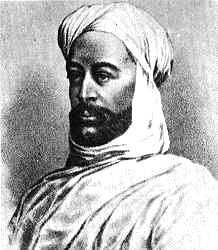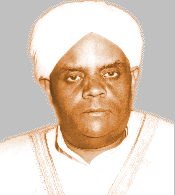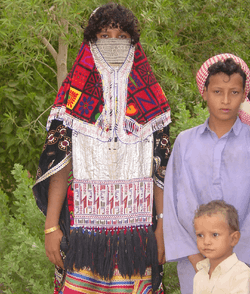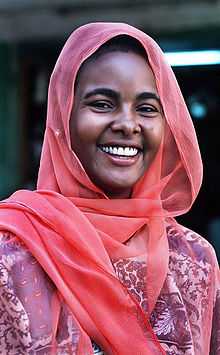Sudanese Arabs
| ||||||||||||||||
| Total population | ||||||||||||||||
|---|---|---|---|---|---|---|---|---|---|---|---|---|---|---|---|---|
| c. 30 million | ||||||||||||||||
| Regions with significant populations | ||||||||||||||||
| 22 million[1] | ||||||||||||||||
| 5 million | ||||||||||||||||
| 1 million[1] | ||||||||||||||||
|
1 million All data from 2009 | ||||||||||||||||
| Languages | ||||||||||||||||
| Arabic | ||||||||||||||||
| Religion | ||||||||||||||||
| Predominantly Sunni Islam; Small numbers of Shia and Coptic Christians | ||||||||||||||||
Sudanese Arabs are the Arabic-speaking majority population of Sudan. They are predominantly Muslim and most of them speak the Sudanese Arabic dialect.
In common with much of the rest of the Arab world, the gradual process of Arabization in Sudan led to the predominance of the Arabic language and aspects of Arab culture,[2] The population of Sudan includes various tribes who are ethnically Arab, such as the Shaigya, Ja'alin, Shukria, Rashaida, etc. (according to Johann Ludwig Burckhardt, the Bedouins of the eastern desert of Sudan such as the Ja'alin are almost indistinguishable from the Bedouins of eastern Arabia.[3]).
Arabized or partially Arabized groups who retain a separate, non-Arab ethnic identity include the Nubians, Copts, Beja.
Regional variation
While most Sudanese Arabs speak some form of Sudanese Arabic, some other Arab tribes speak different Arabic dialects like the Awadia and Fadnia tribes and Bani Arak tribes who speak Najdi Arabic and the Bani Hassan, Al-Ashraf and Rashaida who speak Hejazi Arabic. In addition, Western province tribes like the Baggara and Darfurians) speak Chadian Arabic, although they have great variation in cultural and genealogy aspects.[4] Sudanese Arabs descend primarily from migrants from the Arabian Peninsula and some of the pre-existing indigenous populations of Sudan, most predominately the Nubian people who also share a common history with Egypt. In addition, a few Arabian tribes existed in Sudan prior to the advent of Islam.[5] Nevertheless, most Arab tribes migrated into the Sudan in the 12th century and introduced Islam.[3]
Sudanese Arabic
It was noted in the late 19th century that the Arabic spoken in Sudan still largely maintained grammatical and dialectical features similar to that introduced from the Arabian Peninsula in the 12th century, and as a result Sudanese Arabic is a form of pure or "archaic Arabic."[6] This, among other features, serves to distinguish the Arabic spoken in Sudan from that of its neighbor, Egypt.
Islam
Most Sudanese Muslims are adherents of the Sunni branch of Islam;[7] Sunni Islam in Sudan is not marked by a uniform body of belief and practice, however. Some Muslims opposed aspects of Sunni orthodoxy, and rites having a non-Islamic origin were widespread, being accepted as if they were integral to Islam, or sometimes being recognized as separate. Moreover, Sunni Islam in Sudan (as in much of Africa) has been characterized by the formation of religious orders or brotherhoods, each of which made special demands on its adherents.
Five pillars

Sunni Islam requires its adherents to follow the Five Pillars of Islam. The first pillar, the shahadah or profession of faith is the affirmation "There is no god but God (Allah) and Muhammad is his prophet." It is the first step in becoming a Muslim and a significant part of prayer. The second obligation is prayer at five specified times of the day. The third enjoins almsgiving. The fourth requires fasting during daylight hours in the month of Ramadan. The fifth requires a pilgrimage to Mecca for those able to perform it, to participate in the special rites that occur during the twelfth month of the lunar calendar. Most Sudanese Muslims are born to the faith and meet the first requirement. Conformity to the second requirement is more variable. Many males in the cities and larger towns manage to pray five times a day: at dawn, noon, midafternoon, sundown, and evening. The well-to-do perform little work during Ramadan, and many businesses close or operate on reduced schedules. In the early 1990s, its observance appeared to be widespread, especially in urban areas and among sedentary Sudanese Muslims.

The pilgrimage to Mecca is less costly and arduous for the Sudanese than it is for many Muslims. Nevertheless, it takes time (or money if travel is by air), and the ordinary Sudanese Muslim has generally found it difficult to accomplish, rarely undertaking it before middle age. Some have joined pilgrimage societies into which members pay a small amount monthly and choose one of their number when sufficient funds have accumulated to send someone on the pilgrimage. A returned pilgrim is entitled to use the honorific title hajj or hajjih for a woman.
Another ceremony commonly observed is the great feast Id al Adha (also known as Id al Kabir), representing the sacrifice made during the last days of the pilgrimage. The centerpiece of the day is the slaughter of a sheep, which is distributed to the poor, kin, neighbors, and friends, as well as the immediate family.
Islam imposes a standard of conduct encouraging generosity, fairness, and honesty towards other Muslims. Sudanese Arabs, especially those who are wealthy, are expected by their coreligionists to be generous.
Islam in Sudanese law
In accordance with Islamic law most Sudanese Muslims do not eat pork. Conformity to the prohibitions on gambling and alcohol is less widespread. . Usury is also forbidden by Islamic law, but Islamic banks have developed other ways of making money available to the public. Some Sudanese are skeptical of Islamic Banking -- seeing it as an attempt by the religious elite to mask exploitative capitalist banking practices under a guise of religious sanctity
In Sudan (until 1983) modern criminal and civil, including commercial, law generally prevailed. In the north, however, the sharia, was expected to govern what is usually called family and personal law, i.e., matters such as marriage, divorce, and inheritance. In the towns and in some sedentary communities sharia was accepted, but in other sedentary communities and among nomads local custom was likely to prevail – particularly with respect to inheritance.
In September 1983, Nimeiri imposed the sharia throughout the land, eliminating the civil and penal codes by which the country had been governed in the twentieth century. Traditional Islamic punishments were imposed for theft, adultery, homicide, and other crimes. The zealousness with which these punishments were carried out contributed to the fall of Nimeiri. Nevertheless, no successor government has shown inclination to abandon the sharia.
Other influences
Islam is monotheistic and insists that there can be no intercessors between an individual and God. Nevertheless, Sudanese Islam includes a belief in spirits as sources of illness or other afflictions and in magical ways of dealing with them. The imam of a mosque is a prayer leader and preacher of sermons. He may also be a teacher and in smaller communities combines both functions. In the latter role, he is called a faqih (pl., fuqaha), although a faqih need not be an imam. In addition to teaching in the local Qur'anic school (khalwa), the faqih is expected to write texts (from the Qur'an) or magical verses to be used as amulets and cures. His blessing may be asked at births, marriages, deaths, and other important occasions, and he may participate in wholly non-Islamic harvest rites in some remote places. All of these functions and capacities make the faqih the most important figure in popular Islam. But he is not a priest. His religious authority is based on his putative knowledge of the Qur'an, the sharia, and techniques for dealing with occult threats to health and well- being. The notion that the words of the Qur'an will protect against the actions of evil spirits or the evil eye is deeply embedded in popular Islam, and the amulets prepared by the faqih are intended to protect their wearers against these dangers.
In Sudan as in much of African Islam, the cult of the saint is of considerable importance, although some Muslims would reject it. The development of the cult is closely related to the presence of the religious orders; many who came to be considered saints on their deaths were founders or leaders of religious orders who in their lifetimes were thought to have barakah, a state of blessedness implying an indwelling spiritual power inherent in the religious office. Baraka intensifies after death as the deceased becomes a wali (literally friend of God, but in this context translated as saint). The tomb and other places associated with the saintly being become the loci of the person's baraka, and in some views he or she becomes the guardian spirit of the locality. The intercession of the wali is sought on a variety of occasions, particularly by those seeking cures or by barren women desiring children. A saint's annual holy day is the occasion of a local festival that may attract a large gathering.
Better-educated Muslims in Sudan may participate in prayer at a saint's tomb but argue that prayer is directed only to God. Many others, however, see the saint not merely as an intercessor with and an agent of God, but also as a nearly autonomous source of blessing and power, thereby approaching "popular" as opposed to orthodox Islam.
Movements and religious orders
Islam made its deepest and longest lasting impact in Sudan through the activity of the Islamic religious brotherhoods or orders. These orders emerged in the Middle East in the twelfth century in connection with the development of Sufism, a reaction based in mysticism to the strongly legalistic orientation of mainstream Islam. These orders first came to Sudan in the sixteenth century and became significant in the eighteenth. Sufism seeks for its adherents a closer personal relationship with God through special spiritual disciplines. The exercises (or dhikr) include reciting prayers and passages of the Qur'an and repeating the names, or attributes, of God while performing physical movements according to the formula established by the founder of the particular order. Singing and dancing may be introduced. The outcome of an exercise, which lasts much longer than the usual daily prayer, is often a state of ecstatic abandon.
-

A Dancing dervish
-

A dervish from the 1920s
A mystical or devotional way (sing. tariqa; pl. turuq) is the basis for the formation of particular orders, each of which is also called a tariqa. The specialists in religious law and learning initially looked askance at Sufism and the Sufi orders, but the leaders of Sufi orders in Sudan have won acceptance by acknowledging the significance of the sharia and not claiming that Sufism replaces it.
The principal turuq vary considerably in their practice and internal organization. Some orders are tightly organized in hierarchical fashion; others have allowed their local branches considerable autonomy. There may be as many as a dozen turuq in Sudan. Some are restricted to that country; others are widespread in Africa or the Middle East. Several turuq, for all practical purposes independent, are offshoots of older orders and were established by men who altered in major or minor ways the tariqa of the orders to which they had formerly been attached.
The oldest and most widespread of the turuq is the Qadiriyah founded by Abdul Qadir Jilani in Baghdad in the twelfth century and introduced into Sudan in the sixteenth. The Qadiriyah's principal rival and the largest tariqa in the western part of the country was the Tijaniyah, a sect begun by Sidi Ahmed al-Tidjani at Tijani in Morocco, which eventually penetrated Sudan in about 1810 via the western Sahel (a narrow band of savanna bordering the southern Sahara, stretching across Africa). Many Tijani became influential in Darfur, and other adherents settled in northern Kurdufan. Later on, a class of Tijani merchants arose as markets grew in towns and trade expanded, making them less concerned with providing religious leadership. Of greater importance to Sudan was the tariqa established by the followers of Sayyid Ahmad ibn Idris, known as Al Fasi, who died in 1837. Although he lived in Arabia and never visited Sudan, his students spread into the Nile Valley establishing indigenous Sudanese orders which include the Majdhubiyah, the Idrisiyah, the Ismailiyah, and the Khatmiyyah.
Much different in organization from the other brotherhoods is the Khatmiyyah (or Mirghaniyah after the name of the order's founder). Established in the early nineteenth century by Muhammad Uthman al Mirghani, it became the best organized and most politically oriented and powerful of the turuq in eastern Sudan (see Turkiyah). Mirghani had been a student of Sayyid Ahmad ibn Idris and had joined several important orders, calling his own order the seal of the paths (Khatim at Turuq—hence Khatmiyyah). The salient features of the Khatmiyyah are the extraordinary status of the Mirghani family, whose members alone may head the order; loyalty to the order, which guarantees paradise; and the centralized control of the order's branches.

The Khatmiyyah had its center in the southern section of Ash Sharqi State and its greatest following in eastern Sudan and in portions of the riverine area. The Mirghani family were able to turn the Khatmiyyah into a political power base, despite its broad geographical distribution, because of the tight control they exercised over their followers. Moreover, gifts from followers over the years have given the family and the order the wealth to organize politically. This power did not equal, however, that of the Mirghanis' principal rival, the Ansar, or followers of the Mahdi, whose present-day leader was Sadiq al-Mahdi, the great-grandson of Muhammad Ahmad, who drove the Egyptian administration from Sudan in 1885.
Most other orders were either smaller or less well organized than the Khatmiyyah. Moreover, unlike many other African Muslims, Sudanese Muslims did not all seem to feel the need to identify with one or another tariqa, even if the affiliation were nominal. Many Sudanese Muslims preferred more political movements that sought to change Islamic society and governance to conform to their own visions of the true nature of Islam.
One of these movements, Mahdism, was founded in the late nineteenth century. It has been likened to a religious order, but it is not a tariqa in the traditional sense. Mahdism and its adherents, the Ansar, sought the regeneration of Islam, and in general were critical of the turuq. Muhammad Ahmad ibn as Sayyid Abd Allah, a faqih, proclaimed himself to be al-Mahdi al-Muntazar ("the awaited guide in the right path"), the messenger of God and representative of the Prophet Muhammad, an assertion that became an article of faith among the Ansar. He was sent, he said, to prepare the way for the second coming of the Prophet Isa (Jesus) and the impending end of the world. In anticipation of Judgment Day, it was essential that the people return to a simple and rigorous, even puritanical Islam (see Mahdiyah). The idea of the coming of a Mahdi has roots in Sunni Islamic traditions. The issue for Sudanese and other Muslims was whether Muhammad Ahmad was in fact the Mahdi.
In the century since the Mahdist uprising, the neo-Mahdist movement and the Ansar, supporters of Mahdism from the west, have persisted as a political force in Sudan. Many groups, from the Baqqara cattle nomads to the largely sedentary tribes on the White Nile, supported this movement. The Ansar were hierarchically organized under the control of Muhammad Ahmad's successors, who have all been members of the Mahdi family (known as the ashraf). The ambitions and varying political perspectives of different members of the family have led to internal conflicts, and it appeared that Sadiq al-Mahdi, putative leader of the Ansar since the early 1970s, did not enjoy the unanimous support of all Mahdists. Mahdist family political goals and ambitions seemed to have taken precedence over the movement's original religious mission. The modern-day Ansar were thus loyal more to the political descendants of the Mahdi than to the religious message of Mahdism.
A movement that spread widely in Sudan in the 1960s, responding to the efforts to secularize Islamic society, was the Muslim Brotherhood (Al Ikhwan al Muslimin). Originally the Muslim Brotherhood, often known simply as the Brotherhood, was conceived as a religious revivalist movement that sought to return to the fundamentals of Islam in a way that would be compatible with the technological innovations introduced from the West. Disciplined, highly motivated, and well financed the Brotherhood became a powerful political force during the 1970s and 1980s, although it represented only a small minority of Sudanese. In the government that was formed in June 1989, following a bloodless coup d'état, the Brotherhood exerted influence through its political wing, the National Islamic Front (NIF) party, which included several cabinet members among its adherents.
Christianity

Christianity reached what is now northern Sudan, then called Nubia, by about the end of the first century after Christ.
It greatly developed under the influence of the Eastern Roman Empire.[8] Indeed, Byzantine architecture influenced most of the Christian churches in lower Nubia[9]
The Roman Emperor Justinian I made Nubia a stronghold of Christianity during the Middle Ages.[10] By 580 AD, Christianity had become the official religion of the northern Sudan, centered around the Faras cathedral.
It largely disappeared following later Islamic conquests, but only after a long lasting struggle that went on for eight centuries.
Genetics
The vast majority of Sudanese Arabs' y-dna seem to be of Eurasian origin according to a study by Hassan2008.[11] The greatest Y-DNA contribution is from the haplogroup J (46.7%) which is larger than all other Arabic speaking groups in North Africa. The other prominent contributions are haplogroup E1b1b (16.3%), haplogroup E1b1a (12.5%), haplogroup I (3.13%) and haplogroup R1b (15.39%).
Music
Sudan has a rich and unique musical culture that has been through chronic instability and repression during the modern history of Sudan. Beginning with the imposition of strict sharia law in 1989, many of the country's most prominent poets, like Mahjoub Sharif, were imprisoned while others, like Mohammed el Amin (returned to Sudan in the mid 1990s) and Mohammed Wardi (returned to Sudan 2003), fled to Cairo. Traditional music suffered too, with traditional Zār ceremonies being interrupted and drums confiscated [1]. At the same time, however, the European militaries contributed to the development of Sudanese music by introducing new instruments and styles; military bands, especially the Scottish bagpipes, were renowned, and set traditional music to military march music. The march March Shulkawi No 1, is an example, set to the sounds of the Shilluk.
Clothing
Given the cultural and religious differences within the country, Sudanese clothing varies among the different parts and peoples of Sudan. However, most individual Sudanese wear either traditional or western attire. A traditional garb widely worn in Sudan is the jalabiya, which is a loose-fitting, long-sleeved, collarless ankle-length garment also common to Egypt and Eritrea. The jalabiya is accompanied by a large scarf worn by men, and the garment may be white, colored, striped, and made of fabric varying in thickness, depending on the season of the year and personal preferences.
References
- ↑ 1.0 1.1 Sudan Census of 2002
- ↑ Hurtel, Elizabeth. "Photos of Suakin, on the Red Sea, photolibrary South-Images". South-images.com. Retrieved 26 June 2010.
- ↑ 3.0 3.1 Royal Anthropological Institute of Great Britain and Ireland, JSTOR (Organization) (1888). Journal of the Royal Anthropological Institute of Great Britain and Ireland, Volume 17. p. 16. Retrieved 8 May 2011.
- ↑ The Darfur Conflict: Geography Or Institutions? By Osman Suliman, Mohamed Osman Suliman, P:115
- ↑ "المشاهير | الصفحة الرئيسية". almshaheer.com. Retrieved 12 October 2014.
- ↑ Royal Anthropological Institute of Great Britain and Ireland, JSTOR (Organization) (1888). Journal of the Royal Anthropological Institute of Great Britain and Ireland, Volume 17. p. 11. Retrieved 8 May 2011.
- ↑ Nakhleh, E. (2008). A Necessary Engagement: Reinventing America's Relations with the Muslim World. Princeton University Press. p. 28. ISBN 9781400829989. Retrieved 12 October 2014.
- ↑ Christianity in Nubia. nubianet.org
- ↑ Geoffrey S. Mileham (1910). Churches in lower Nubia. University Museum. pp. 67–.
- ↑ Christian Nubia and the Eastern Roman Empire. rumkatkilise.org
- ↑ Hassan, HY; Underhill, PA; Cavalli-Sforza, LL; Ibrahim, ME (2008). "Y-chromosome variation among Sudanese: restricted gene flow, concordance with language, geography, and history". American Journal of Physical Anthropology 137 (3): 316–23. doi:10.1002/ajpa.20876. PMID 18618658.
Further reading
- A History of the Arabs in the Sudan and Some Account of the People who ... (1922)
- A history of the Arabs in the Sudan and some account of the people who preceded them and of the tribes inhabiting Darfur (1922)
- A history of the Arabs in the Sudan and some account of the people who preceded them and of the tribes inhabiting Dárûr (1922)
- A history of the Arabs in the Sudan and some account of the people who preceded them and of the tribes inhabiting Darfur (1922)
- A history of the Arabs in the Sudan and some account of the people who preceded them and of the tribes inhabiting Dárûr (1922)











_006.jpg)
